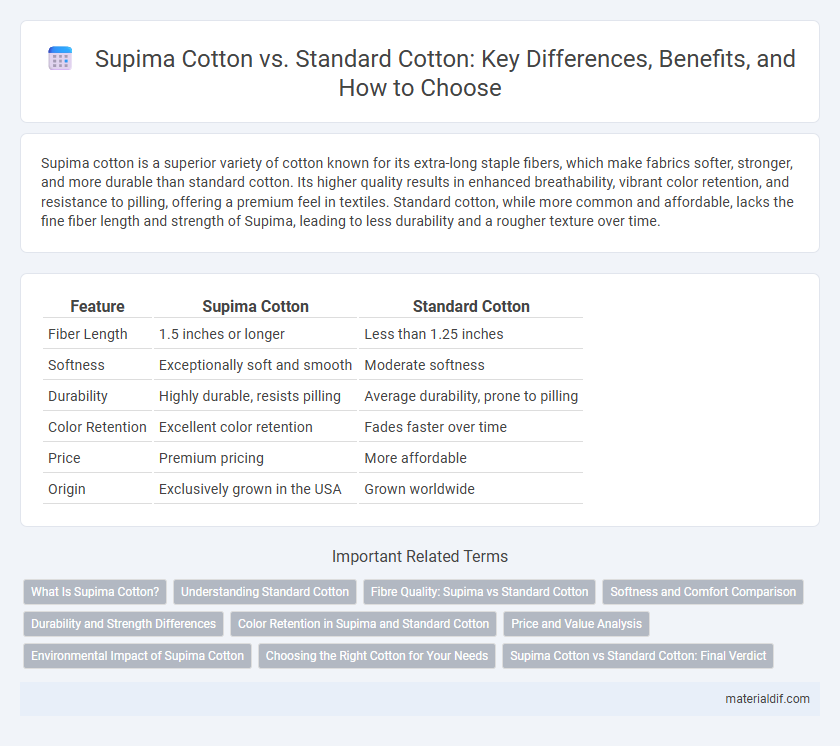Supima cotton is a superior variety of cotton known for its extra-long staple fibers, which make fabrics softer, stronger, and more durable than standard cotton. Its higher quality results in enhanced breathability, vibrant color retention, and resistance to pilling, offering a premium feel in textiles. Standard cotton, while more common and affordable, lacks the fine fiber length and strength of Supima, leading to less durability and a rougher texture over time.
Table of Comparison
| Feature | Supima Cotton | Standard Cotton |
|---|---|---|
| Fiber Length | 1.5 inches or longer | Less than 1.25 inches |
| Softness | Exceptionally soft and smooth | Moderate softness |
| Durability | Highly durable, resists pilling | Average durability, prone to pilling |
| Color Retention | Excellent color retention | Fades faster over time |
| Price | Premium pricing | More affordable |
| Origin | Exclusively grown in the USA | Grown worldwide |
What Is Supima Cotton?
Supima cotton is a premium type of extra-long staple (ELS) cotton grown exclusively in the United States, known for its superior softness, strength, and durability compared to standard cotton varieties. It represents less than 1% of the cotton grown worldwide, making it a rare and high-quality fabric choice often used in luxury textiles. The longer fibers of Supima cotton result in smoother, more resilient fabric that resists pilling and maintains vibrant color over time.
Understanding Standard Cotton
Standard cotton, primarily consisting of upland cotton varieties, features shorter fibers averaging 1 to 1.25 inches in length, which results in a less smooth and durable fabric compared to Supima cotton. It is widely cultivated and used globally due to its affordability and availability, but its shorter staple length often leads to pilling and reduced strength in textiles. Understanding the fiber length, quality, and cultivation techniques of standard cotton is crucial for manufacturers aiming to balance cost-effectiveness with fabric performance.
Fibre Quality: Supima vs Standard Cotton
Supima cotton exhibits superior fiber quality compared to standard cotton, characterized by longer staple length, finer fiber diameter, and enhanced strength. These properties result in softer, more durable fabrics with increased resistance to pilling and fading. Supima cotton fibers typically measure around 1.5 inches or longer, whereas standard cotton fibers are shorter and coarser.
Softness and Comfort Comparison
Supima cotton, known for its extra-long staple fibers, offers superior softness and comfort compared to standard cotton, resulting in a smoother, more luxurious feel against the skin. Its durability allows fabrics to maintain softness after multiple washes, while standard cotton tends to roughen over time. The enhanced breathability and moisture-wicking properties of Supima cotton further contribute to an elevated comfort level ideal for premium apparel and bedding.
Durability and Strength Differences
Supima cotton, grown exclusively in the United States, offers significantly greater durability and tensile strength compared to standard cotton varieties due to its extra-long staple fibers. These fibers provide superior resistance to pilling, tearing, and wear, resulting in longer-lasting garments and textiles. Standard cotton, with shorter staples, tends to degrade faster under similar conditions, making Supima a preferred choice for premium, high-performance fabrics.
Color Retention in Supima and Standard Cotton
Supima cotton offers superior color retention compared to standard cotton due to its extra-long staple fibers, which absorb dye more effectively and resist fading over time. The fiber's smooth surface and strength allow fabrics to maintain vibrant hues after multiple washes. Standard cotton, with shorter fibers, tends to hold color less efficiently, resulting in quicker fading and a duller appearance.
Price and Value Analysis
Supima cotton, grown exclusively in the USA, commands a higher price than standard cotton due to its superior fiber length, strength, and softness, which contribute to enhanced durability and comfort. While standard cotton offers affordability, Supima's premium quality results in longer-lasting fabrics and better color retention, justifying its elevated cost. Consumers seeking luxury textiles and long-term value often prefer Supima cotton despite the price premium, reflecting its well-established market reputation.
Environmental Impact of Supima Cotton
Supima cotton, a premium variety of extra-long staple cotton grown primarily in the USA, typically requires less water and fewer pesticides than standard cotton, contributing to a lower environmental footprint. Its superior fiber strength and durability reduce textile waste by extending garment lifespan, promoting sustainability throughout the product lifecycle. The cultivation of Supima cotton emphasizes responsible farming practices, supporting soil health and minimizing chemical runoff compared to conventional cotton production.
Choosing the Right Cotton for Your Needs
Supima cotton, grown exclusively in the U.S., offers superior fiber length and strength compared to standard cotton, resulting in softer, more durable fabrics ideal for luxury bedding and high-end apparel. Standard cotton, widely available and versatile, suits everyday use with moderate texture and durability, making it cost-effective for mass-market clothing and home textiles. Selecting Supima or standard cotton depends on your priorities for softness, longevity, and budget, ensuring the best match for comfort and performance.
Supima Cotton vs Standard Cotton: Final Verdict
Supima cotton, grown exclusively in the United States, is renowned for its extra-long staple fibers that provide superior softness, strength, and durability compared to standard cotton. It offers enhanced breathability and color retention, making garments more comfortable and longer-lasting. For consumers seeking premium quality and exceptional performance, Supima cotton is the definitive choice over standard cotton varieties.
Supima Cotton vs Standard Cotton Infographic

 materialdif.com
materialdif.com